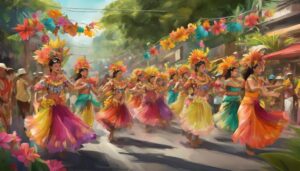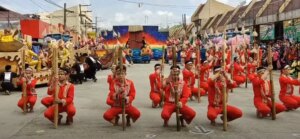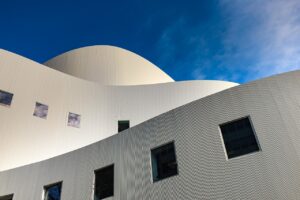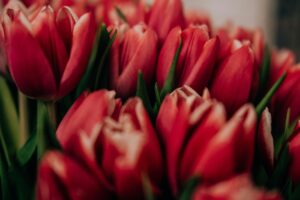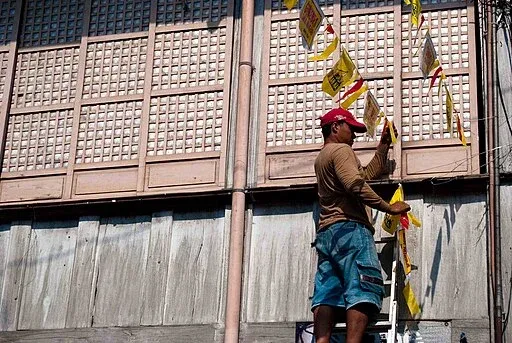
Pahiyas Festival Philippines
Image Source:Yla Corotan, CC BY-SA 3.0, via Wikimedia Commons
Welcome to the Pahiyas Festival in the vibrant town of Lucban, Quezon, Philippines. This agricultural festivity is celebrated every May in honor of San Isidro Labrador, the patron saint of farmers.
During this festival, the residents of Lucban adorn their houses with colorful decorations made of kiping, and rice wafers that have been dyed and shaped into intricate designs.
As a visitor, you can witness the lively religious processions, partake in the harvest of Thanksgiving activities, and immerse yourself in the rich Filipino traditions that make this celebration so unique.
The vibrant, colorful houses and the festive atmosphere will leave you in awe of the May celebrations in this region. The Pahiyas Festival is a must-see if you want to experience the true spirit of the Quezon Province.
Key Takeaways:
- Harvest Thanksgiving and San Isidro Labrador: The Pahiyas Festival in Lucban, Quezon is a celebration of gratitude and harvest, honoring the patron saint of farmers, San Isidro Labrador.
- Lucban Decorations and Kiping: The festival is known for its vibrant and intricate decorations made of colorful rice wafers called “Kiping,” which adorn the houses and streets of Lucban.
- Filipino Traditions and Religious Processions: The Pahiyas Festival is a testament to the rich cultural heritage of the Philippines, with religious processions, traditional dances, and music playing a significant role in the festivities.
Facts About Pahiyas Festival
| Facts | Explanation |
|---|---|
| Name | Pahiyas Festival |
| Type | Cultural and Religious Festival |
| Festival Etymology | The word “Pahiyas” is derived from the Filipino word “hiyas,” which means “jewel” or “ornament.” The festival is named as such because it showcases various colorful decorations made from rice, fruits, vegetables, and other agricultural products, which are considered valuable and precious. |
| First Celebration | May 15, 1963 |
| Founder | Lucban Tourism Council |
| Brief History | The Pahiyas Festival originated in the town of Lucban, Quezon Province, Philippines. It began in 1963 as a way for the locals to express gratitude for a bountiful harvest. The festival has since evolved into a grand celebration of Lucban’s rich agricultural heritage and culture. During the festival, houses are adorned with colorful decorations made of rice, fruits, vegetables, and other agricultural products. A friendly competition among residents encourages creativity and artistry in decorating their homes. The festival also includes a procession, cultural performances, street dances, and various contests showcasing local talents. Today, the Pahiyas Festival attracts tourists from all over the world who come to witness the vibrant display of artistry and celebrate the town’s agricultural abundance. |
| City History | The word “Pahiyas” is derived from the Filipino word “hiyas,” which means “jewel” or “ornament.” The festival is named as such because it showcases various colorful decorations made from rice, fruits, vegetables, and other agricultural products, which are considered valuable. |
| Ethnic Information | Majority: Tagalog |
| Location | Lucban, Quezon Province, Philippines |
| How to Reach | Lucban is a municipality located in the province of Quezon, Philippines. It was founded in 1595 by Franciscan friars and was originally inhabited by indigenous Tagalog people. Lucban played a significant role during the Spanish colonial period and was a center of trade and commerce. The town has preserved its Spanish-era architecture, including the San Luis Obispo Church, which is considered a national cultural treasure. Lucban is known for its warm and hospitable locals who take pride in their cultural heritage and a strong sense of community. |
| Nearby Cities/Towns | – Tayabas City (5 km) – Majayjay (18 km) – Lucena City (34 km) – Dolores (40 km) – Mauban (43 km) – San Pablo City (43 km) – Pagbilao (48 km) – Sariaya (49 km) – Calauag (68 km) – Candelaria (70 km) – Atimonan (80 km) – Gumaca (82 km) – Tiaong (86 km) – Liliw (92 km) – Nagcarlan (92 km) – Real (97 km) – Dolores (110 km) – Pagsanjan (110 km) – Santa Cruz (111 km) |
| Google Map Link | Lucban, Quezon Province, Philippines |
| Festival Main Events | – House Decoration Contest – Street Dancing Competition – Cultural Performances – Agricultural Product Exhibits – Procession – Art Exhibitions – Cooking Competitions – Beauty Pageants – Trade Fairs – Night Market |
| Famous Tourist Attractions | – San Luis Obispo Church: A Spanish-era church with impressive architecture and historical significance. – Kamay ni Hesus Healing Church: A pilgrimage site known for its towering statue of Jesus Christ and healing masses. – Taytay Falls: A picturesque waterfall located in nearby Majayjay. – Mount Banahaw: A sacred mountain revered by spiritual seekers and nature enthusiasts. – Kipot Twin Falls: Twin waterfalls nestled in the lush forests of Lucban. |
| Famous Food Dishes | – Pancit Habhab: A local delicacy made of stir-fried noodles served on a banana leaf and eaten without utensils. – Longganisang Lucban: A special type of sausage made with native spices and herbs. – Pansit Lucban: A flavorful noodle dish seasoned with local ingredients such as shrimp paste and vinegar. – Kesong Puti: A white cheese made from carabao’s milk, often eaten with bread or used as a topping for various dishes. |
| Landmarks | – San Luis Obispo Church: Known for its beautiful façade and religious significance. – Kamay ni Hesus Healing Church: Features a towering statue of Jesus Christ and offers healing masses. – Pahiyas Museum: Showcases the history and cultural heritage of the Pahiyas Festival. – Lucban Town Plaza: The central park where various activities and events take place during the festival. |
| Related Festivals | Sampaguita Festival – Held in nearby San Pedro City, Laguna, it celebrates the city’s official flower, the Sampaguita. Niyogyugan Festival – Celebrated in Quezon Province to honor the coconut industry, which is an important part of the region’s economy. Pista ng Lucban – A religious festival held in Lucban to honor its patron saint, San Isidro Labrador. |
The Essence of Pahiyas
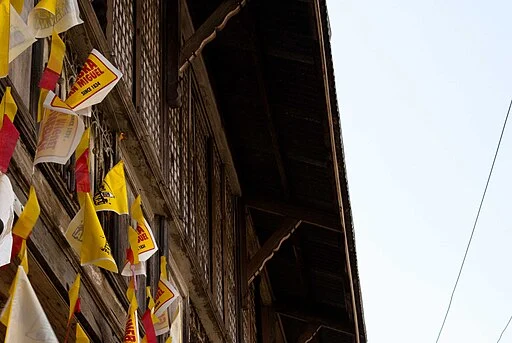
Some of the most vibrant and lively celebrations in the Philippines happen during May. One of the most anticipated festivals is the Pahiyas Festival in Lucban, Quezon.
This colorful and bountiful celebration is a true testament to the Filipino spirit, and it holds a deeply rooted significance in the hearts of the people.
Harvest Thanksgiving Traditions
During the Pahiyas Festival, you will witness the locals expressing gratitude for the bountiful harvest they have received throughout the year.
The festival is a way for them to show their appreciation for a fruitful farming season and the abundance of blessings that have come their way.
You will see houses adorned with colorful decorations made from agricultural produce such as rice, fruits, and vegetables, symbolizing the bountiful harvest that they are thankful for.
Honoring San Isidro Labrador
San Isidro Labrador is the patron saint of farmers and is highly revered during the Pahiyas Festival. You will witness religious processions and ceremonies dedicated to honoring San Isidro Labrador for his intercession in providing a bountiful harvest.
The festival is a true reflection of the deep religious faith of the Filipino people, and you will feel the positive and spiritual energy as you take part in the celebrations.
Cultural Manifestations
If you want to truly experience the rich culture of the Philippines, you should attend the Pahiyas Festival in Lucban, Quezon.
This event is a cultural manifestation of the people’s gratitude for a bountiful harvest, as well as a religious tribute to San Isidro Labrador, the patron saint of farmers.
The colorful and vibrant decorations adorning the houses, as well as the unique art of kiping, are a testament to the Filipino traditions and the agricultural festivity celebrated in the Quezon province.
The Vibrancy of Lucban Decorations
One of the most striking aspects of the Pahiyas Festival is the elaborate and colorful decorations that adorn the houses in Lucban.
You will be in awe of the creative displays made from agricultural products, local handicrafts, and a variety of colorful flowers. The designs are not only visually appealing but also symbolize prosperity and abundance.
The entire town comes alive with a riot of colors, making it a truly memorable experience for every visitor.
The Unique Art of Kiping
Another unique feature of the Pahiyas Festival is the art of making kiping, a leaf-shaped wafer made from rice paste. These colorful, translucent decorations are intricately designed and arranged to form various shapes and patterns, adding to the vibrant display of the festival.
As you walk through the streets, you can’t help but admire the skill and artistry involved in creating these delicate ornaments.
However, it’s important to note that while kiping adds beauty to the festival, it can also be quite delicate and should be handled with care. Be mindful of the kiping decorations and avoid touching them to prevent any damage.
Festivities and Rituals
After the colorful decorations and preparations, the Pahiyas Festival in Lucban, Quezon kicks off with a series of festivities and rituals.
These events are deeply rooted in Filipino traditions and are a way for the locals to express gratitude, celebrate blessings, and seek a bountiful harvest.
The festival is a vibrant showcase of the Filipino spirit and culture, and you can’t help but be drawn into the lively and joyous atmosphere.
May Celebrations and Their Significance
The May celebrations during the Pahiyas Festival are significant as they coincide with the start of the harvest season. This is a time for thanksgiving and paying homage to San Isidro Labrador, the patron saint of farmers.
As you witness the May celebrations, you’ll see various offerings and rituals that symbolize the community’s reliance on agriculture and their respect for the earth’s bounty.
It’s a beautiful display of the Filipino people’s deep connection to the land and the importance of agricultural traditions in their lives.
Religious Processions and Agricultural Festivity
Religious processions play a significant role in the Pahiyas Festival, with locals parading through the streets adorned in traditional attire and carrying images of San Isidro Labrador.
During this time, you’ll witness fervent prayers and hymns dedicated to the patron saint, as well as blessings for the year’s harvest. The agricultural festivity is also marked by showcases of local products, traditional crafts, and agricultural produce, serving as a reminder of the significance of farming in the community.
The religious processions and agricultural festivities are a testament to the deep-rooted faith and the rich cultural heritage of the people of Lucban.
Pahiyas Festival in the Context of Filipino Traditions
Your visit to the Pahiyas Festival in Lucban, Quezon offers you a unique opportunity to witness and experience the rich tapestry of Filipino traditions.
This annual event is a celebration of the bountiful harvest and a time for thanksgiving to San Isidro Labrador, the patron saint of farmers.
The festival is deeply rooted in the culture and history of the Philippines, reflecting the agrarian way of life and the importance of communal celebration.
Integration with National Culture
The Pahiyas Festival is a vibrant display of the integration of Filipino culture and traditions. The colorful decorations, known as “Kiping,” which adorn the houses are a testament to the Filipino people’s artistic and creative expression.
The festival also features religious processions and traditional folk dances, showcasing the enduring influence of Spanish colonial heritage on the local customs.
Impact on Local Community and Economy
The Pahiyas Festival plays a crucial role in the local community and economy. The event attracts a large number of tourists and visitors, providing an economic boost for the businesses in Lucban.
It also fosters a sense of community pride and solidarity, as residents come together to decorate their houses and participate in the festivities.
The celebration not only promotes local craftsmanship and agricultural products but also strengthens the social fabric of the community.
Summary Of Pahiyas Festival
| Category | Facts |
|---|---|
| Festival Name | Pahiyas Festival |
| Location | Lucban, Quezon, Philippines |
| Patron Saint | San Isidro Labrador |
| Origin | Dates back to the 15th century as a thanksgiving ceremony |
| Official Founding | 1963 by Fernando Cadeliña Nañawa |
| Decoration | Locals decorate their houses with fruit, vegetables, flowers, and produce |
| Ornamental Items | Dates back to the 15th century as a Thanksgiving ceremony |
| ‘Kalas’ Procession | People grab produce from decorated houses |
| Festivities | Competitions, parades, cultural performances, exhibits, and fiestas |
| Food | Filipino dishes like Pancit Habhab and Lucban Pilpit |
| Socializing | Locals invite neighbors and visitors to feast, dance, and socialize |
| Souvenirs | Native hats, bags, and food parcels |
Here are some important pages for more information on the Pahiyas Festival:
FAQ
Q: What is the Pahiyas Festival in Lucban, Quezon Philippines?
A: The Pahiyas Festival is a harvest Thanksgiving festival held in Lucban, Quezon, Philippines, to honor San Isidro Labrador, the patron saint of farmers. It is a colorful and vibrant celebration that showcases Filipino traditions, agricultural festivity, and religious processions.
Q: What are the key features of the Pahiyas Festival?
A: The Pahiyas Festival is known for its intricate and colorful decorations made of rice wafers called “Kiping,” which adorn the houses in Lucban. The festival also includes various May celebrations, such as street dancing and cultural performances. The highlight of the festival is the display of colorful houses adorned with fruits, vegetables, and handicrafts, symbolizing a bountiful harvest.
Q: What is the significance of the Pahiyas Festival to the Quezon Province?
A: The Pahiyas Festival is a significant event for the Quezon Province as it not only celebrates the abundance of agricultural produce but also promotes tourism and cultural heritage. It attracts local and international visitors who come to witness the stunning decorations, partake in the festivities, and experience the warm hospitality of the Filipino people.

